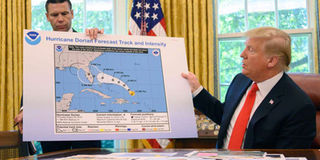Trump displays incorrectly altered map of Hurricane Dorian path

US President Donald Trump and Acting US Secretary of Homeland Security Kevin McAleenan update the media on Hurricane Dorian preparedness from the Oval Office at the White House in Washington, DC, September 4, 2019. PHOTO | JIM WATSON | AFP
What you need to know:
- US President displayed a map from the National Hurricane Center (NHC) showing the devastating storm's initial predicted path but gave wrong trajectory.
- Trump incorrectly tweeted on Sunday that Alabama was among the states affected by the hurricane.
- The National Weather Service's (NWS) office in Birmingham, Alabama later on in a tweet ruled out Alabama from the list of states affected, contrary to President Trump's initial statement
Washington,
Trouble is raining down on US President Donald Trump, who appears to have given Americans incorrect information on Hurricane Dorian's trajectory.
During an Oval Office press conference Wednesday, Trump displayed a map from the National Hurricane Center (NHC) showing the devastating storm's initial predicted path.
As he held up the poster board to give the journalists present a better view, it became clear the map had been edited: Dorian's cone had been extended with what appeared to be black marker to include the state of Alabama.
CLUELESS
When asked a few hours later about the surprising addition, Trump responded, "I don't know. I don't know," while continuing to maintain that the initial storm predictions included the possibility that Dorian would make landfall in the southern state.
Trump had incorrectly tweeted Sunday that Alabama was among the states -- as well as Florida, Georgia and the Carolinas -- that could be affected by the hurricane.
Not long after, the National Weather Service's (NWS) office in Birmingham, Alabama appeared to respond to the contrary, though it did not explicitly mention Trump's tweet.
"Alabama will NOT see any impacts from #Dorian," it tweeted.
"We repeat, no impacts from Hurricane #Dorian will be felt across Alabama. The system will remain too far east."





